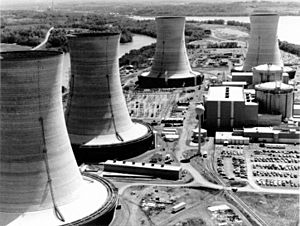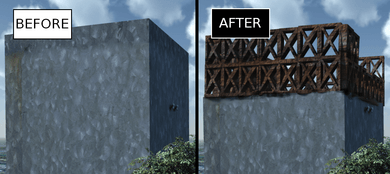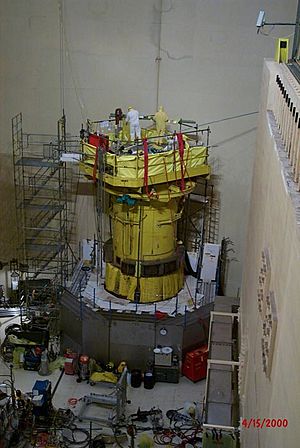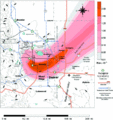Nuclear accident facts for kids
By now, the most serious nuclear accident has been the Chernobyl disaster in 1986. Other serious nuclear accidents include Fukushima Daiichi Nuclear Power Plant accident, Three Mile Island accident, the Windscale fire, Mayak accident, and the SL-1 accident. In the period to 2007, 63 major nuclear accidents have occurred at nuclear power plants. Twenty-nine of these have occurred since the Chernobyl disaster, and 71 percent of all nuclear accidents (45 out of 63) occurred in the United States.
Contents
Fukushima, Onagawa and Tōkai
On 11 March 2011, the Magnitude 9.0 devastating Sendai earthquake and tsunami took place in Japan. As a result, Fukushima Daiichi Nuclear Power Plant, Fukushima Daini Nuclear Power Plant, Onagawa Nuclear Power Plant and Tōkai Nuclear Power Plant stations consisting of eleven (11) reactors were automatically shut down following the earthquake.
At Fukushima Daiichi and Daini tsunami waves went over seawalls and destroyed diesel backup power systems. This loss of power caused severe problems including two large explosions at Fukushima Daiichi and leakage of radiation. Over 200,000 people have been evacuated. Seismic recordings at six assessed nuclear power plant facilities indicated the plants had been exposed to peak ground accelerations of 0.037–0.383 g and peak ground velocities of 6.18–52.62 cm/sec.
One year after the accident, the official death toll related to the Fukushima accident has been five: one caused by the earthquake, another one had a heart attack, two people drowned, and a last person died in October for unreported causes. None of the deaths have been caused by radiation.
Chernobyl disaster
The Chernobyl disaster was a major accident at the Chernobyl Nuclear Power Plant on April 26, 1986, with an explosion at the plant and later radioactive contamination of the surrounding area. It is so far the worst nuclear accident in the history of nuclear power. A plume of radioactive fallout drifted over parts of the western Soviet Union, Eastern and Western Europe, Scandinavia, the UK, Ireland and eastern North America. Large areas of Ukraine, Belarus, and Russia were badly damaged, forcing the people in charge to have to evacuate and resettle more than 336,000 people. About 60% of the radioactive fallout landed in Belarus, according to official post-Soviet data.
The accident made many people worried about the safety of the Soviet nuclear power industry. As a result, plans for more nuclear plants were put on hold and the Soviet government, who were not very open with its data, had to make public more of its data. The now-independent countries of Russia, Ukraine, and Belarus have had to spend a lot of money and time on decontamination and health care costs of the Chernobyl accident. Nobody knows how many people died because of this accident. This is because the Soviets covered up information, did not fully complete lists, and did not let doctors list "radiation" as the reason why some people died. Most of the expected long-term deaths, such as that from cancer, have not yet happened and it is hard to say that Chernobyl was the full reason for their deaths.
At Fukushima I and II tsunami waves overtopped seawalls and destroyed diesel backup power systems, leading to severe problems including two large explosions at Fukushima I and leakage of radiation.
Three Mile Island accident

On March 28, 1979, the Unit 2 nuclear power plant on the Three Mile Island Nuclear Generating Station (TMI-2) in Dauphin County, Pennsylvania near Harrisburg suffered a partial core meltdown.
The Three Mile Island accident was the worst accident in American commercial nuclear power generating history, even though it led to no deaths or injuries to plant workers or members of the nearby community.
The accident unfolded over the course of five tense days, as a number of agencies at local, state and federal level tried to diagnose the problem and decide whether or not the on-going accident required a full emergency evacuation of the population. The full details of the accident were not discovered until much later. In the end, the reactor was brought under control. Although approximately 25,000 people lived within five miles of the island at the time of the accident, no identifiable injuries due to radiation occurred, and a government report concluded that "the projected number of excess fatal cancers due to the accident... is approximately one". But the accident had serious economic and public relations consequences, and the cleanup process was slow and costly. It also furthered a major decline in the public popularity of nuclear power, exemplifying for many the worst fears about nuclear technology and, until the Chernobyl disaster seven years later, it was considered the world's worst civilian nuclear accident.
Davis-Besse
Davis-Besse Nuclear Power Station is a nuclear power plant with a single reactor located on the southwest shore of Lake Erie near Oak Harbor, Ohio. According to the Nuclear Regulatory Commission, Davis-Besse has been the source of two of the top five most dangerous nuclear incidents in the United States since 1979.
SL-1 accident
The SL-1, or Stationary Low-Power Reactor Number One, was a United States Army experimental nuclear power reactor which underwent a steam explosion and meltdown in January 1961, killing its three operators. The direct cause was the improper withdrawal by a maintenance team of a single reactor control rod. The event is the only reported fatal reactor accident in the United States.
Windscale fire
On October 10, 1957, the graphite core of a British nuclear reactor at Windscale, Cumbria, caught fire, releasing substantial amounts of radioactive contamination into the surrounding area. The event, known as the Windscale fire, was considered the world's worst nuclear accident until the Three Mile Island accident in 1979.
The fire itself released an estimated 20,000 curies (700 |terabecquerels) of radioactive material into the nearby countryside. Of particular concern was the radioactive isotope iodine-131, which has a half-life of only 8 days but is taken up by the human body and stored in the thyroid. As a result, consumption of iodine-131 often leads to cancer of the thyroid.
No one was evacuated from the surrounding area, but there was concern that milk might be dangerously contaminated. Milk from about 500 km² of nearby countryside was destroyed (diluted a thousandfold and dumped in the Irish Sea) for about a month.
Mayak accident
Mayak is the name of a nuclear fuel reprocessing plants 150 km northwest of Chelyabinsk in Russia. Working conditions at Mayak resulted in severe health hazards and many accidents, with a serious accident occurring in 1957.
The 1957 Kyshtym disaster occurred when the failure of the cooling system for a tank storing tens of thousands of tons of dissolved nuclear waste resulted in a non-nuclear explosion having a force estimated at about 75 tons of TNT (310 gigajoules), which released some 20 MCi (740 petabecquerels) of radiation. Subsequently, at least 200 people died of radiation sickness, 10,000 people were evacuated from their homes, and 470,000 people were exposed to radiation.
Attacks on nuclear plants
Nuclear reactors become easy targets during military conflict and, over the past three decades, have been repeatedly attacked:
- Between 18 December 1977 and 13 June 1979: attacks on Lemoniz Nuclear Power Plant in Spain while it was still under construction.
- In September 1980: Iran bombed the Al Tuwaitha nuclear complex in Iraq, in Operation Scorch Sword.
- In June 1981: an Israeli air strike completely destroyed Iraq’s Osirak nuclear research facility.
- On 8 January 1982: Umkhonto we Sizwe attacked Koeberg Nuclear Power Station in South Africa while it was still under construction.
- Between 1984 and 1987: Iraq bombed Iran’s Bushehr nuclear plant six times.
- In Iraq in 1991: The U.S. bombed three nuclear reactors and an enrichment pilot facility.
- In 1991: Iraq launched Scud missiles at Israel’s Dimona nuclear power plant.
- In September 2003: Israel bombed a Syrian reactor under construction.
Radiation accidents
Radiation is harmful to health and there have been many accidents caused by radiation:
- 17 fatalities – Instituto Oncologico Nacional of Panama, August 2000 -March 2001. patients receiving treatment for prostate cancer and cancer of the cervix receive lethal doses of radiation.
- 13 fatalities – Radiotherapy accident in Costa Rica, 1996. 114 patients received an overdose of radiation from a Cobalt-60 source that was being used for radiotherapy.
- 11 fatalities – Radiotherapy accident in Zaragoza, Spain, December 1990. Cancer patients receiving radiotherapy; 27 patients were injured.
- 10 fatalities – Columbus radiotherapy accident, 1974–1976, 88 injuries from Cobalt-60 source.
- 8 fatalities – Radiation accident in Morocco, March 1984.
- 7 fatalities – Houston radiotherapy accident, 1980.
- 5 fatalities – Lost radiation source, Baku, Azerbaijan, USSR, October 5, 1982. 13 injuries.
- 4 fatalities – Goiânia accident, September 13, 1987. 249 people received serious radiation contamination from lost radiography source.
- 4 fatalities – Radiation accident in Mexico City, 1962.
- 3 fatalities – Three deaths and ten injuries resulted in Samut Prakarn, Thailand when a radiation-therapy unit was dismantled, February 2000.
- 1 fatality – Mayapuri radiological accident, India, April 2010.
- 1 fatality – Malfunction INES level 4 at RA2 in Buenos Aires, Argentina, operator Osvaldo Rogulich dies days later.
Related pages
Images for kids
-
Following the 2011 Japanese Fukushima nuclear disaster, authorities shut down the nation's 54 nuclear power plants. The Fukushima site remains radioactive, with some 30,000 evacuees still living in temporary housing, although nobody has died or is expected to die from radiation effects. The difficult cleanup job will take 40 or more years, and cost tens of billions of dollars.
-
The abandoned city of Pripyat, Ukraine, following the Chernobyl disaster. The Chernobyl nuclear power plant is in the background.
-
Dr. Joseph G. Hamilton was the primary researcher for the human plutonium experiments done at U.C. San Francisco from 1944 to 1947. Hamilton wrote a memo in 1950 discouraging further human experiments because the AEC would be left open "to considerable criticism," since the experiments as proposed had "a little of the Buchenwald touch."
-
One of four example estimates of the plutonium (Pu-239) plume from the 1957 fire at the Rocky Flats Nuclear Weapons Plant near Denver, Colorado. Public protests and a combined Federal Bureau of Investigation and United States Environmental Protection Agency raid in 1989 stopped production at the plant.
-
Corroded and leaking 55-gallon drum, for storing radioactive waste at the Rocky Flats Plant, tipped on its side so the bottom is showing.
-
The Hanford site represents two-thirds of USA's high-level radioactive waste by volume. Nuclear reactors line the riverbank at the Hanford Site along the Columbia River in January 1960.
-
The 18,000 km2 expanse of the Semipalatinsk Test Site (indicated in red), which covers an area the size of Wales. The Soviet Union conducted 456 nuclear tests at Semipalatinsk from 1949 until 1989 with little regard for their effect on the local people or environment. The full impact of radiation exposure was hidden for many years by Soviet authorities and has only come to light since the test site closed in 1991.
-
Over 2,000 nuclear tests have been conducted, in over a dozen different sites around the world. Red Russia/Soviet Union, blue France, light blue United States, violet Britain, black Israel, yellow China, orange India, brown Pakistan, green North Korea and light green Australia (territories exposed to nuclear bombs)
-
Radioactive materials were accidentally released from the 1970 Baneberry Nuclear Test at the Nevada Test Site.
-
The recovered thermonuclear bomb was displayed by U.S. Navy officials on the fantail of the submarine rescue ship U.S.S. Petrel after it was located in the sea off the coast of Spain at a depth of 762 meters and recovered in April 1966
See also
 In Spanish: Accidente nuclear para niños
In Spanish: Accidente nuclear para niños


















